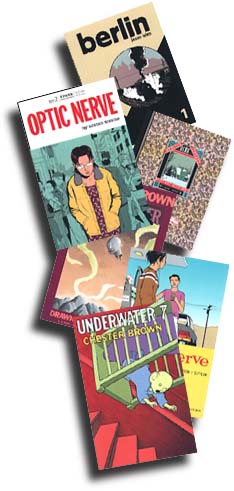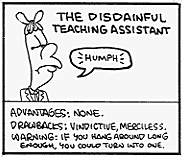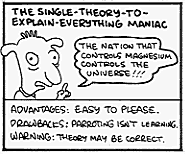|
World War I clobbered the German and French film industries, allowing American producers to build up their overseas distribution offices and gear up for a post-war invasion of the world's theaters. After they took over the world's distribution and exhibition, American studios established the standards of a "professional" and "well-made" film---standards, of course, far too expensive for any nation (besides the U.S. and First World hyper-capitalism) to afford. That's why Pakistan will never produce a Jurassic Park, and that's why we'll never see a level playing field in the world's film markets.
Although I could complain about Hollywood's hegemony for pages, and bore you silly in the process, I instead want to discuss a different medium and other kinds of distribution injustices. Specifically: comic books, as an industry and as an art form, are in terrible shape these days, and many of its problems were caused by the distribution crises and monopolistic takeovers that have defined comics as a business during the '90s.
 Yet despite the crummy shape of the comics business, four books--Acme Novelty Library, Berlin, Optic Nerve, and Underwater--have made impressive contributions to comics ART while managing to sell (barely) enough copies to keep their creators in clothes, food, and shelter. So in this article we'll first eat our Brussel sprouts and find out what a fucked-up business comics is; then we'll feast on dessert as I celebrate some little alternative comics that deserve your support. Yet despite the crummy shape of the comics business, four books--Acme Novelty Library, Berlin, Optic Nerve, and Underwater--have made impressive contributions to comics ART while managing to sell (barely) enough copies to keep their creators in clothes, food, and shelter. So in this article we'll first eat our Brussel sprouts and find out what a fucked-up business comics is; then we'll feast on dessert as I celebrate some little alternative comics that deserve your support.
One note: many of the facts about the comics business presented in this article are cribbed from The Comics Journal, comic fandom's most intelligent and toughest-minded magazine of news and criticism. Go out and buy a copy, won't you?

I wish little imps delivered popular culture directly to our homes, bringing us movie tickets, comic books, videos and CDS in beautifully-woven wicker baskets. But I live in a college town with a low population of fantasy creatures, so I have to special-order older CDs (most recently Sebadoh III) from poorly-stocked stores and wait for quirky movies like Cold Comfort Farm to appear at the one theater in town that regularly programs art films. Until a couple of years ago, however, comics distributors and retailers had been better at supplying me with steady capitalistic gratification; I visited my local comics shop every Thursday and could greedily buy the same new comics available to readers in New York or Seattle. But this gratification is gone, a victim of distribution upheavals in the comics industry in the last two years.
Like most forms of mass popular culture, the comic business operates according to a production-distribution-retail system. First, publishers package and print the books. The market has traditionally been dominated by two big companies, Marvel and DC comics, although a number of mid-level and small publishers (Image, Dark Horse, Fantagraphics, Slave Labor) have also survived and thrived. These publishers then send completed books to distributors responsible for shipping the comics to individual stores and other outlets. Since the 1970s, comic book businesspeople have counted on the direct market, the network of comic book stores found in cities and college towns, for most of their business; the publishers and distributors control print runs and regulate inventory by selling to comic stores according to a big-discount, non-returnable agreement. So comic book vendors are able to purchase the newest issue of Mighty Moose for a very low wholesale price, but are not allowed to return Mighty Moose to the publishers or distributors for a refund if the issue goes unsold.
In 1994, after more than a decade of this production-distribution-retail system, Marvel comics began to branch out into distribution and retail. First, Marvel set up its own mail-order house and ran ads in their comics for book collections and merchandise not available to retailers. If you wanted those Mighty Moose condoms, in other words, you had to order them directly from Marvel--you couldn't get them anywhere else. (Subsequent retailer uproar made Marvel scale back their mail-order operation.) Marvel also spread rumors about starting their own chains of comic book stores, a step that would further cut into that segment of the market traditionally run by independent retailers. But Marvel's most audacious invasion of the distribution and retail wings of the comics market came with their purchase of Heroes World, a previously independent East coast distributor. With the buy-out came new terms for retailers: if you wanted to carry Marvel comics in your store, you had to get them from Heroes World. Marvel stopped sending their comics to other distributors, and began to jockey for a vertically-integrated hegemony over the entire comic book market.
The result was chaos. Distributors, panicked over Marvel's boycott, quickly contracted with other publishers to distribute their books on an exclusive basis. Thus Diamond Distributors became the sole handlers of DC Comics, while Capital Distribution evolved into the exclusive distributor of Kitchen Sink and Viz Comics. Individual comics retailers were now forced to use five or six different distributors to order the diverse comics and products that had been previously available from a single company. Most store owners tried to make do with two or three distributors, and thus comic book availability became spotty and unreliable; no store in my hometown of Champaign, Illinois ordered with Capital/Kitchen Sink, for instance, so I had to make a hegira to Chicago to buy the final three issues of Alan Moore and Eddie Campbell's magisterial From Hell.
Quirky, adult books like From Hell also went without proper distribution because comic fans overwhelmingly prefer superhero comics instead of more challenging, more artistic fare. More than any other American popular culture medium, comics are linked with one single genre: superheroes. Imagine ninety-five percent of the nation's movie theaters playing Schwarzenegger action films, and you have an accurate sense of how much superheroes dominate the comic book market. (Some of these superhero comics, like Watchmen and Astro City, are pretty sharp, but most are irredeemable, immature crap.) This preeminence of superheroes has been the status quo since the late 1950s, despite the fact that the medium has attracted artists like Robert Crumb, Justin Green, Bill Griffith, Art Spiegelman, Chester Brown, Howard Cruse, Gilbert and Jamie Hernandez, Carol Tyler, Jim Woodring, Dan Clowes and Roberta Gregory, who do comic books for ADULTS rather than for superhero fans. But these fans, of course, steer the warped rudder of the comics business, and during the distributor wars Marvel and DC glutted the market with superhero drivel, while comic shop owners continued to order bucketfuls of superhero comics and skipped alternatives like Love and Rockets and Eightball.
So what have alternative, non-superhero publishers done to survive in this marketplace? Well, let's see: the people who frequent comic stores are overwhelmingly male (over 90 percent, according to industry polls), and readers of stories where men in skin-tight costumes constantly battle, bump and rub up against each other. It seems almost inevitable that many alternative companies, including Fantagraphics and Slave Labor, have stooped to dishing out porno comics, and it's equally unsurprising that X-rated comics sell well to these sexually maladjusted fans. So Fantagraphics, for instance, has subsidized the publication of intelligent but marginally profitable comics like Unsupervised Existence and Palestine by operating a subsidiary called Eros Comics, devoted to the lucrative dis-semen-ation of such deathless works of art as Hot Tails and Talk Dirty. I can understand Fantagraphics' need to turn some kind of a profit, but I wonder if the pervy comics strategy doesn't do more long-term harm than good; it blurs the distinction between mature adult comics, which sometimes explicitly deal with sexual themes, and the jerk-off stuff. A friend of mine (Hi, Holly!) who's an editor for a book publisher told me that she once saw a table for Fantagraphics at a booksellers' convention, but she also spotted some of their porno comics on display, and avoided the table like she would a dirty toilet seat. How can we get mature, adult comics to an audience beyond the nerds in the comic book stores? How can we get more women to read these comics? The answer doesn't lie in publishing Wendy Whitebread, Undercover Slut.
page 1 of 2

|


 Groening draws this mad teacher with floppy ears and dark rings under his eyes (not unlike the way I look after a late night of grading papers), and writes him a word balloon that perfectly encapsulates his mania: "The nation that controls magnesium controls the universe!!!" Now, I'm not a Single-Theory-To-Explain-Everything-Maniac because I worship magnesium.
Groening draws this mad teacher with floppy ears and dark rings under his eyes (not unlike the way I look after a late night of grading papers), and writes him a word balloon that perfectly encapsulates his mania: "The nation that controls magnesium controls the universe!!!" Now, I'm not a Single-Theory-To-Explain-Everything-Maniac because I worship magnesium.
 In fact, I'm not sure what magnesium IS. Rather, my magnesium is distribution: I believe that he who controls the distribution channels by which movies and comics and CDs reach the public controls popular culture. American films are shown around the globe, for example, not because of innate aesthetic superiority, but because of historical precedent.
In fact, I'm not sure what magnesium IS. Rather, my magnesium is distribution: I believe that he who controls the distribution channels by which movies and comics and CDs reach the public controls popular culture. American films are shown around the globe, for example, not because of innate aesthetic superiority, but because of historical precedent. 
 Yet despite the crummy shape of the comics business, four books--Acme Novelty Library, Berlin, Optic Nerve, and Underwater--have made impressive contributions to comics ART while managing to sell (barely) enough copies to keep their creators in clothes, food, and shelter. So in this article we'll first eat our Brussel sprouts and find out what a fucked-up business comics is; then we'll feast on dessert as I celebrate some little alternative comics that deserve your support.
Yet despite the crummy shape of the comics business, four books--Acme Novelty Library, Berlin, Optic Nerve, and Underwater--have made impressive contributions to comics ART while managing to sell (barely) enough copies to keep their creators in clothes, food, and shelter. So in this article we'll first eat our Brussel sprouts and find out what a fucked-up business comics is; then we'll feast on dessert as I celebrate some little alternative comics that deserve your support.
